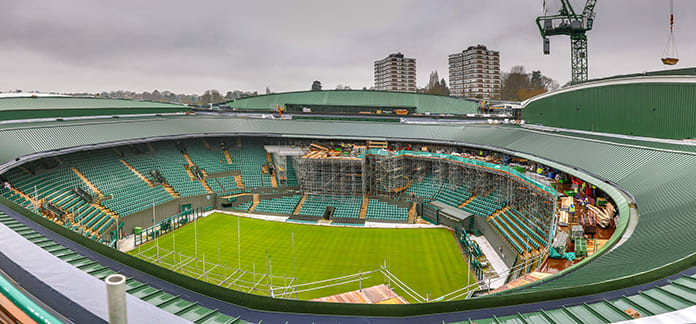Envelope contractor Prater, a keen BIM advocate, has seen its investment in the technology pay off with high-profile contract awards such as Wimbledon’s No 1 Court. CM finds out about the firm’s digital strategy.
For the past few years, Prater has made BIM investment a key strategic priority, becoming the first building envelope specialist to achieve Level 2 accreditation in 2016.
The company’s expertise has helped it win bigger and higher-profile contracts, and was central to its approach on the second phase of Wimbledon’s No 1 Court, completed in time for the 2018 Championships this month. BIM was a critical part of the project.
Appointed by main contractor Sir Robert McAlpine, Prater’s scope of works includes fitting a BEMO standing seam metal roofing system, a waterproof hot melt package, and cladding to the outer wall facade with Bailey soffits installed to both the inner and outer bowl.
“BIM has been crucial for this project primarily because of the complex geometry of the roofing system,” says Adam Fisher, senior designer at Prater. “The inner bowl soffits also incorporate a number of penetrations for lights and ventilation, so it was key to run clash detection to reduce interface risks with M&E.

Prater’s BIM visualisation of its work at Wimbledon No 1 Court (below) and the actual construction project
“To facilitate the smooth delivery, Prater and its trusted supply chain all worked from the same model, checking every interface as we went around the bowl. With the complex geometry of the system, this would have been incredibly difficult and time consuming to do in 2D.”
The opportunity to put its BIM skills into practice at Wimbledon is reward for Prater’s investment.
“Although adoption throughout the construction industry has been slow, we’ve positioned ourselves at the forefront of digital engineering, investing a significant amount into BIM so far,” says managing director Gavin Hamblett.
“We do have some designers who are largely still working in 2D, but this is down to the design legacy of the large projects they are working on. Ultimately, our plan is that by 2020 our entire design team will be working in 3D design.”
While investing in its people, Prater has also built on its offsite facilities to drive digitally led fabricated solutions.
“Initial investments were made into training and software, but we are now making strides in linking our 3D designs to automatic manufacturing processes,” says Hamblett.
“In 2017 we invested £200k into our factories and this year we will be making a similar investment. Equipment such as the new four-axis CNC machine installed at our Thurrock site allows us to upload files from the BIM model directly to the machine, rather than manually programming it for each work package. This has increased capacity at the factory and provides high-quality, highly precise components ready for installation on site.”
BIM models are also an essential part of the bidding process for Prater. “When we bid for major projects now, we not only produce a 3D or 4D model to clarify our scope and to animate the construction sequence, but we also clearly articulate our BIM proposal,” says technical director Stuart Whiting. “Clients like that as it demonstrates professionalism.”
Hamblett recognises that construction is only at the beginning of a long digital journey, but says: “Those with the ability to lead the necessary change must do so to future-proof our industry. At Prater, as we clarify our future-proofing strategy, we will be motivating our key supply chain partners to take the methodologies on board and do the same.
“None of us can complete the high-profile projects we work on independently. We must take our collaborative working ethos found on site and implement it to other avenues within our businesses. BIM is fundamental to this.”













